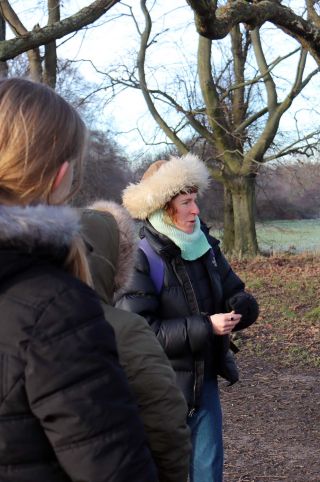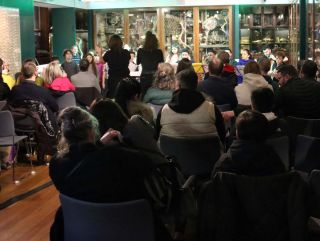Environment
Singing for Mental Health Under Climate Change
A new composition offers positive future visioning.
Posted December 14, 2023 Reviewed by Gary Drevitch
Key points
- Children experience eco-anxiety and climate grief partly due to doomist reporting.
- A composer-musician used climate change science to write a piece about positive futures.
- Working with children to sing and understand the piece supports their mental health.

Sing for a positive future. And counter the bombardment of negativity, eco-anxiety, climate grief, and doomism.
This approach drove a scientist-artist-community collaboration for supporting mental health and well-being under human-caused climate change. I was the scientist for the project with composer Heloise Tunstall-Behrens, who was supported by my employer, University College London (UCL), through UCL Culture and the UCL Grand Challenges Fund. UCL colleague Peter Irvine, lecturer in climate change and solar geoengineering, contributed scientific insights while writer Robert MacFarlane provided the words for the song.
The collaboration aimed to understand how climate change science could offer positive ways forward if society acted collectively to create a better future. Tunstall-Behrens adopted these ideas to compose a new three-act music piece called The Work of Many Hands. The focus was supporting children’s mental health and well-being through realistic, positive future envisioning.
Many Hands and Minds Together
Science is clear that extinction scenarios of humanity being wiped out by human-caused climate change are unrealistic. Whether disasters, forced migration, or health, we can avoid many (although certainly not all) adverse impacts, irrespective of how we are changing the climate.
From available knowledge and known effective actions, society should never become mired in or even emphasise climate grief and eco-anxiety, instead focusing on eco-inspiration and climate hope. Tunstall-Behrens’s music is uplifting while MacFarlane’s lyrics convey the needed messaging about positive, collaborative, and science-based action: The Work of Many Hands.
Tunstall-Behrens contacted and coordinated with a primary school in London to involve their pupils. A session held in a nearby park questioned the children about stopping climate change, avoiding disasters, and building a future they wanted. The kids then illustrated their expectations for the future by using the park’s materials of dirt, leaves, and branches. The children connected nature and their preferred future, especially the mental health benefits of thriving nature within positive futures.
This collaboration culminated in a performance with the children and a professional ensemble at the UCL Grant Museum of Zoology and Comparative Anatomy. Watched over by skeletons and specimens of humanity’s ancestors, the performers and audience were asked to live out the words of Jonas Salk, of polio vaccine fame: “Our greatest responsibility is to be good ancestors”.

The piece journeys through the coming decades in which greenhouse gas emissions peak, level out, and then decline over the three acts matching three generations. In Act 1, "The Rise (Hope in the Dark)", the children portray themselves, witnessing humanity’s impacts on the world, highlighting rivers, forests, oceans, and ice. The video offers a red tone shifting to a blue tone. Act 2 is "The Levelling (Beneath the Forest)", in which the blue segues to green as the children have become parents, reduced greenhouse gas emissions, and moved toward sustainability. The children are grandparents in Act 3, "The Fall (Good Ancestors)", reminiscing about their successes. Life thrives on Earth through the video’s full colour spectrum as the lyrics reflect on how to continue being good ancestors for future generations.
Why art, science, and community?
So, why music? And why involve the children and the community? Why does science alone not convince people to be more realistic about all the doom-laden climate change communication that leads to poor mental health through anxiety, grief, and gloom? When accurate information for evidence-based action is available, why do some lead the way and others sink into despondency?
Because people are different. They communicate differently and respond to different messages. Further, we should never neglect children, instead working with them on their terms in order to learn from them. As musicians and scientists have long known, music and music training used wisely instil positive emotions, support youth creativity and positive development, stimulate memory, and can contribute to bonding and collective sustainability action. When art, science, and community join together, everyone learns from and brings joy to each other.
And the process is typically fun. Enjoying work and activities can be important for getting through difficult times and for doing more for ourselves and others—through music, research, and especially people.
References
Albrecht, G.A. 2019. Earth Emotions: New Words for a New World. Cornell University Press, Ithaca, NY.
Albrecht, G.A. 2020. Negating Solastalgia: An Emotional Revolution from the Anthropocene to the Symbiocene. American Imago, vol. 77, no. 1, 9-30.
Flores, E. C., Kelman, I., Yannick, J., & Bolderdijk, J. W., Ayeb-Karlsson, S., Wutich, A., Ayalon, L., & Hickman, C. (2022). Voices: A healthy planet for a healthy mind. One Earth, 5, 307-310.




